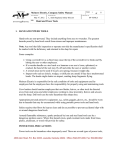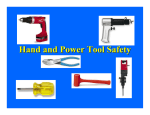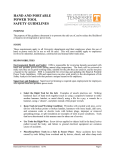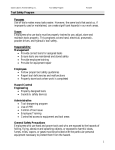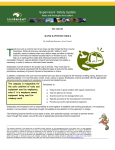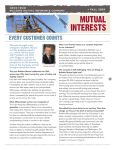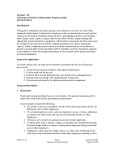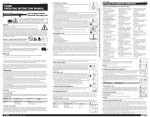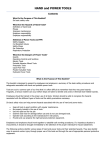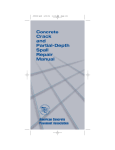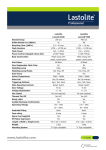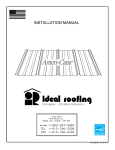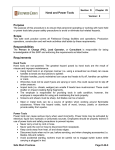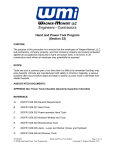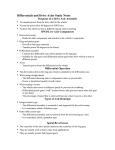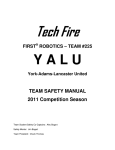Download Tool Safety Program
Transcript
Ardent Services, LLC Safety Manual Document No.: Tool Safety Program O-SS-SPP-0022 Safety Manual Sect: B.20 Page 1 of 6 Revision: 4 Rel Date: March 2013 Tool Safety Program 1. Purpose • This program covers hand, electrical, pneumatic, powder driven, and hydraulic tool safety. 2. General Safety Precautions • Employees who use hand and power tools and who are exposed to the hazards produced by those tools must be provided with the appropriate personal protective equipment necessary to protect them from the hazard. • Any tool that does not meet the requirements described in this section shall be taken out of service, tagged and forwarded to the responsible Operations office for repair or replacement. 3. Hand Tool Precautions • Hand tools are non-powered tools. The greatest hazards posed by hand tools result from misuse and improper maintenance. • Only Ardent approved or Ardent provided hand tools are allowed. • Ardent approved hand tools designed for cutting and splicing include a short fixed straight blade knife with a flat tip such as the Klein knife pictured below, or other Ardent provided tools such as those found in approved terminating kits or tools specifically approved by the local Ardent District Management group. • Ardent strictly prohibits the use of razor knives (with or without a retractable blade), knives with curved blades, folding knives without a locking blade and knives with sharp points. • All hand tools must be inspected prior to each use. • Cutting tools must remain sharp and maintained appropriately. • Appropriate personal protective equipment must be worn due to hazards that may be encountered while using hand tools. • Kevlar or other cut-resistant gloves must be worn at all times while utilizing hand tools for cutting purposes. Ardent Services, LLC Safety Manual Document No.: Tool Safety Program O-SS-SPP-0022 Safety Manual Sect: B.20 Page 2 of 6 Revision: 4 Rel Date: March 2013 4. Power Tool Precautions • There are several types of power tools based on the power source they use: electric, pneumatic, liquid fuel, hydraulic, and powderactuated. • The following general precautions should be observed by power tool users: • • • • • • • • • • • • Never carry a tool by the cord or hose. Never yank the cord or the hose to disconnect it from the receptacle. Keep cords and hoses away from heat, oil, and sharp edges. Disconnect tools when not in use, before servicing, and when changing accessories such as blades, bits and cutters. All observers should be kept at a safe distance away from the work area or must wear the same level of PPE as the equipment user. Secure work with clamps or a vise, freeing both hands to operate the tool. Avoid incidental starting. Do not hold a finger on the switch button while carrying a plugged-in tool. Tools should be maintained with care. They should be kept sharp and clean for the best performance. Follow instructions in the user's manual for lubricating and changing accessories. Be sure to keep good footing and maintain good balance. The proper apparel should be worn. Loose clothing, ties, or jewelry can become caught in moving parts. All portable electric tools that are damaged shall be removed from service and tagged "Do Not Use." Never use an electric powered tool that has the ground conductor missing. 5. Guards • Safety guards must never be removed or modified when a tool is being used. 6. Safety Switches Ardent Services, LLC Safety Manual Document No.: Tool Safety Program O-SS-SPP-0022 Safety Manual Sect: B.20 • • • Page 3 of 6 Revision: 4 Rel Date: March 2013 The following hand-held powered tools are to be equipped with a momentary contact "on-off" control switch: • Drills • Fastener drivers, • Horizontal, vertical and angle grinders with wheels larger than 2 inches in diameter • Disc and belt sanders • Reciprocating saws The following hand-held powered tools may be equipped with only a positive "on-off" control switch: • Platen sanders • Disc sanders with discs 2 inches or less in diameter • Grinders with wheels 2 inches or less in diameter • Routers • Planers • Laminate trimmers • Nibblers • Shears • Scroll saws and jigsaws with blade shanks ¼-inch wide or less. Other hand-held powered tools such as circular saws having a blade diameter greater than 2 inches, chain saws, and percussion tools without positive accessory holding means must be equipped with a constant pressure switch that will shut off the power when the pressure is released. 7. Electrical Safety • All electrical tools must either have a three-wire cord with ground, be double insulated, or be powered by a low-voltage isolation transformer. 8. Electric Power Tool General Safety Practices: • • • • Electric tools should be operated within their design limitations. Gloves and safety footwear are recommended during use of electric tools. When not in use, tools should be stored in a dry place. Electric tools should not be used in damp or wet locations. Ardent Services, LLC Safety Manual Document No.: Tool Safety Program O-SS-SPP-0022 Safety Manual Sect: B.20 • Page 4 of 6 Revision: 4 Rel Date: March 2013 Work areas should be well lighted. 9. Powered Abrasive Wheel Tools • Before an abrasive wheel is mounted, it should be inspected closely and sound- or ring-tested to be sure that it is free from cracks or defects. To test, wheels should be tapped gently with a light nonmetallic instrument. If they sound cracked or dead, they could fly apart in operation and must not be used. A sound and undamaged wheel will give a clear metallic tone or "ring." • To prevent the wheel from cracking, the user should be sure it fits freely on the spindle. The spindle nut must be tightened enough to hold the wheel in place, without distorting the flange. Care must be taken to assure that the spindle wheel will not exceed the abrasive wheel specifications. • Due to the possibility of a wheel disintegrating (exploding) during startup, the employee should never stand directly in front of the wheel as it accelerates to full operating speed. • Portable grinding tools need to be equipped with safety guards to protect workers not only from the moving wheel surface, but also from flying fragments in case of breakage. 10. Pneumatic Tools • Pneumatic tools are powered by compressed air and include saws, drills, hammers, and sanders. • Eye and face protection is required for employees working with pneumatic tools. • Working with noisy tools such as jackhammers requires proper hearing protection. • Hoses shall have the proper operating pressure rating and must be securely coupled to each other or to the equipment and shall be pinned where couplings can accommodate. • Safety check valves should be installed at the air supply source to automatically shut down the air supply in the event of unexpected disconnects or ruptures in the air line. • A safety clip or retainer must be installed to prevent attachments, such as chisels on a chipping hammer, from being unintentionally shot from the barrel. Ardent Services, LLC Safety Manual Document No.: Tool Safety Program O-SS-SPP-0022 Safety Manual Sect: B.20 • Page 5 of 6 Revision: 4 Rel Date: March 2013 Screens must be set up to protect nearby workers from being struck by flying fragments around chippers, riveting guns, staplers, or air drills. 11. Powder-Actuated Tools • • • • • • • • • • These tools should not be used in an explosive or flammable atmosphere. Before using the tool, the worker should inspect it to determine that it is clean, that all moving parts operate freely, and that the barrel is free from obstructions. The tool should never be pointed at anybody. The tool should not be loaded unless it is to be used immediately. A loaded tool should not be left unattended, especially where it would be available to unauthorized persons. Hands should be kept clear of the barrel end. The tools must not be able to operate until they are pressed against the work surface with a force of at least 5 pounds greater than the total weight of the tool. If a powder-actuated tool misfires, the employee should wait at least 30 seconds, and then try firing it again. If it still will not fire, the user should wait another 30 seconds so that the faulty cartridge is less likely to explode, than carefully remove the load. The bad cartridge should be put in water. The muzzle end of the tool must have a protective shield or guard centered perpendicularly on the barrel to confine any flying fragments or particles that might otherwise create a hazard when the tool is fired. All powder-actuated tools must be designed for varying powder charges so that the user can select a powder level necessary to do the work without excessive force. If the tool develops a defect during use it should be tagged and taken out of service immediately until it is properly repaired. 12. Powder-Actuated Tool Fasteners • Fasteners must not be fired into material that would let them pass through to the other side. • The fastener must not be driven into materials like brick or concrete any closer than 3 inches to an edge or corner. • In steel, the fastener must not come any closer than one-half inch from a corner or edge. • Fasteners must not be driven into very hard or brittle materials which might chip or splatter, or make the fastener ricochet. Ardent Services, LLC Safety Manual Document No.: Tool Safety Program O-SS-SPP-0022 Safety Manual Sect: B.20 Page 6 of 6 Revision: 4 Rel Date: March 2013 • An alignment guide must be used when shooting a fastener into an existing hole. • A fastener must not be driven into a spalled area caused by an unsatisfactory fastening. 13. Hydraulic Power Tools • The fluid used in hydraulic power tools must be an approved fireresistant fluid and must retain its operating characteristics at the most extreme temperatures to which it will be exposed. • The manufacturer's recommended safe operating pressure for hoses, valves, pipes, filters, and other fittings must not be exceeded. • All jacks - lever and ratchet jacks, screw jacks, and hydraulic jacks must have a device that stops them from jacking up too high. • The manufacturer's load limit must be permanently marked in a prominent place on the jack and should not be exceeded. • A jack should never be used to support a lifted load. Once the load has been lifted, it must immediately be blocked up. • To set up a jack, make certain of the following: 14. Jacks • • • • The base rests on a firm level surface The jack is correctly centered The jack head bears against a level surface The lift force is applied evenly • Proper maintenance of jacks is essential for safety. • All jacks must be inspected before each use and lubricated regularly. • If a jack is subjected to an abnormal load or shock, it should be thoroughly examined to make sure it has not been damaged. • Hydraulic jacks exposed to freezing temperatures must be filled with adequate antifreeze liquid.






